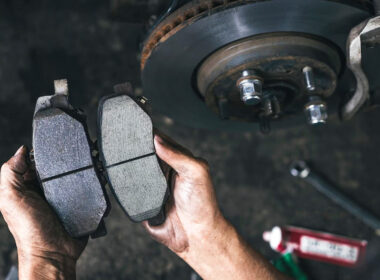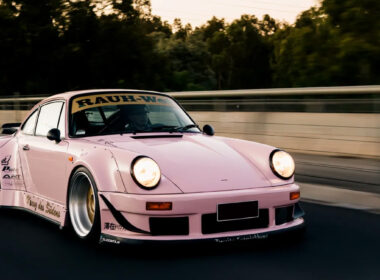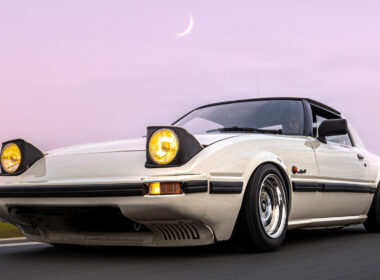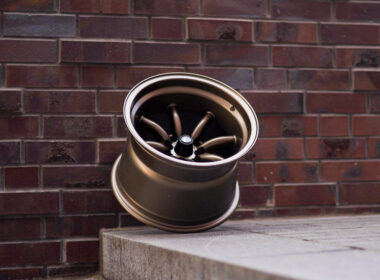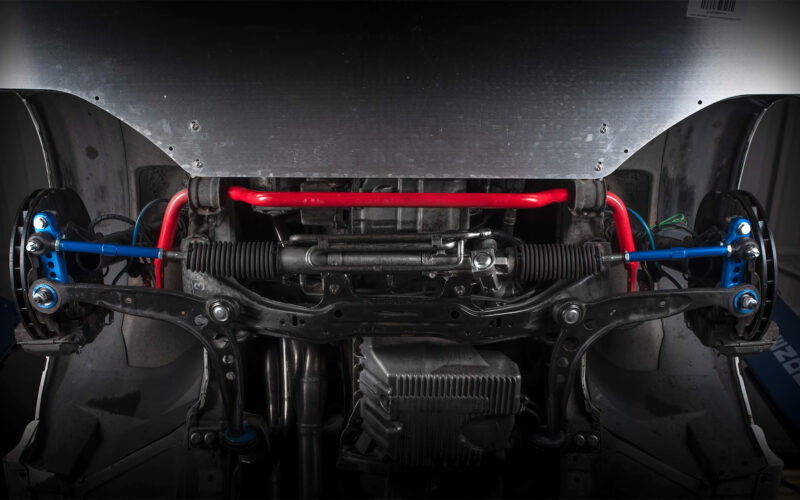Getting good at drifting demands dedication, patience, and a ton of seat time. Once you’ve got the hang of it, you can dial things up a notch by installing an angle kit. This is the best way to get more range out of your steering rack.
The extra angle will make a world of difference and help you compound your skill-set. You’ll have a stronger command over your car as it will let you crank in more opposite lock, initiate aggressively, and carry the drift for longer.
Here you’ll find the best angle kits for your car, including some vital information you need to know before installing one.
The What, Why, and How of Angle Kits

Most stock cars have only about 30° of steering angle each way. While it’s not impossible to drift with ~30°, having more helps, particularly if you’ve already perfected the technique. With an angle kit installed, you can expect to go all the way up to 60° or more.
One of the first mechanical limitations on stock steering racks is the inner tie rod end bottoming out on the rack housing. Tie rod to control arm clearance is another major limiter.
Angle kits are a curated solution meant to avoid these problems. Providing additional leverage to push your steering knuckles further out and making more room to clear your tires are the primary functions of an angle kit.

Depending on how well designed and comprehensive the kit is, it will also let you adjust various suspension and steering geometry parameters.
Like most other curated “kits” such as turbo kits and lift kits, it is possible to assemble your own angle kit, mix and match parts made by different manufacturers, or just fabricate your own.
Many enthusiasts get cut knuckles made, use steering rack spacers, remove factory bump stops, lengthen their control arms, and relocate their tie-rod ends to achieve whatever steering angle and geometry they’re after.
Buying a readymade angle kit is just easier as it saves you a lot of time, research, and effort in general. Having said that, it helps to know exactly what’s included in the angle kit and what the individual components do.
What’s In the Box?

What an angle kit consists of depends on the car it’s made for and how expensive it is. Generally, the more expensive it is, the more parts it includes, providing more avenues for steering and suspension geometry adjustment.
Every angle kit manufacturer does things differently, but they all have a common goal. Here are some of the parts you can expect to find in the box when you buy an angle kit:
- Steering plates: Allow you to reposition the tie rod end in relation to the control arm, providing more leverage and consequently more angle. These also allow for Ackermann adjustment and roll center correction.
- Short knuckles: Complements any changes in tie rod repositioning for more steering angle. Shorter knuckles will speed up your steering ratio, which translates to fewer turns on the steering wheel for the same amount of angular displacement on the wheels.
- Adjustable control arms: These are all about clearance and suspension geometry correction. They’re longer and feature cut outs on the inside that provide much-needed room for your tires when you’re at full lock.
- Extended tie rods: You’ll either receive an extended tie rod or some sort of adapter that lets you elongate your existing tie rod — very important for all that extra angle.
- Top hats: These are beefier and are meant to reinforce the strength of your suspension setup. They’ll also provide you let you adjust wheel alignment specs like camber and caster.
- Various adapters and hardware: All the hardware you’re going to need to bolt everything in place.
With some cars, even with an angle kit installed, you won’t have all the clearance you need as the spring perch might be in the way. In this case, you’re going to have to cut a good chunk of it to clear your tires. This is a common issue, especially with some Mustangs.
Angle Kit Adjustments

In addition to increasing the steering angle, angle kits affect the following suspension and steering alignments:
- Steering ratio: Ratio between the angle of your steering wheel and the angle of your wheels.
- Ackermann angle: A geometric configuration that allows your wheels to follow concentric circles around a common center point when steered.
- Roll centre: A theoretical point about which the mass of your car rolls when cornering.
- Camber: Refers to the off-vertical inward or outward tilt of your wheels.
- Caster: The forward or rearward tilt of the steering axis relative to the vertical axis.
- Toe: The angle between each wheel relative to the longitudinal axis of your car.
- Bump steer: The tendency of your wheels to steer themselves without any driver input, particularly when driving over bumps.
- Steering axis inclination: The axis about which your wheels pivot when they turn.
- Scrub radius: When viewed from the front, this refers to the distance between your steering axis and the center of your tire’s contact patch.
Of these, roll centre, steering ratio, and Ackermann are the main actionable adjustments in angle kits while others are more cause-effect in nature. Let’s take a closer look at some of these.
Ackermann Steering Geometry

Ackermann is basically how much the wheels differ in toe angle when they’re steered. It’s a geometric configuration that prevents the front wheels from being exactly parallel to each other while turning (not drifting).
Your leading wheel is supposed to turn more than the outer wheel, only then will the two follow concentric circles around a common center point without slipping.
The purpose of Ackermann steering geometry is to get your front tires to operate at their optimal slip angles while cornering so they produce the most lateral force and traction.
Side note: Slip angle is the difference between the tire’s direction and the contact patch’s orientation. It deforms under force.

Production cars utilize positive Ackermann steering, which means the leading wheel turns in more than the trailing wheel, allowing the two to turn along their natural paths without slipping.
Interestingly, some race cars use anti-Ackermann or reverse Ackermann to compensate for the massive difference in slip angle between the leading and trailing tires when turning at high speed — you need a greater slip angle on the outside tire since it’s going to be under more load at those speeds, which means it’ll deform the contact patch even more.
Drift cars, on the other hand, are a whole different ballgame. The rules change when it comes to these because the wheels are set up for a different job. The general consensus is that you don’t need a lot of Ackermann on your drift car; positive but closer to zero is most preferred.
Overlooking your Ackermann settings when installing an angle kit is asking for trouble. Failure to do so might cause your tie rods to bind (over-center), and your car won’t handle the way you need it to.

“Need” being the operative word; Ackerman settings are entirely a personal choice. Most drivers prefer reduced Ackermann, some want zero (parallel steering) and a few, typically those from a gaming background, actually prefer anti-Ackermann.
To put things into perspective, here’s a diagram explaining the 3 types of Ackermann settings, followed by a brief summary of how each setup affects handling.
- Positive: Lets you angle through corrections smoothly but causes more scrub on the trailing wheel, reducing speed and maximizing lock limitation.
- Zero: Provides the most amount of lock but encourages over-centering at the same time on both wheels.
- Reverse: Ensures minimal scrub and max speed but also makes the car harder and unintuitive to drive since we’re all used to positive Ackermann.
Although the ideal Ackermann geometry serves as a theoretical model, real-world applications often differ substantially due to packaging constraints, manufacturing tolerances, and the necessity to balance low-speed maneuverability with high-speed stability.
Additionally, Ackermann geometry is non-linear makes things even more nuanced. This is mainly because of the steering rack location. For instance, it is possible that at 35° of steering lock, you get reverse Ackermann, at 45° the wheels exhibit parallel steering, and at 60°, you get positive Ackermann. It totally depends on the car.
Steering Ratio

Steering ratio refers to ratio between the amount of turns you put on your steering vs how much the wheels turn. More accurately, it’s the ratio between the control arm ball joint and the outer tie rod ball joint.
Ideally, after you install an angle kit, you should be able to turn your steering wheel the same amount of times as before to achieve full lock. This is an issue with some kits, where one turn on the steering wheel is all it takes to go full lock. Some people like that, others don’t.
This is something to consider if especially if you have both an angle kit and an aftermarket steering wheel installed. Another consideration is that some cars have a variable steering ratio with varying tooth pitch on the steering rack. If your car has variable steering ratio, then you might have to do things differently when installing an angle kit.
Do You Need an Angle Kit to Drift?

Is big angle really necessary? This is a question that gets asked a lot, and for good reason.
Short answer: Yes, if you’re competing in events where you get judged on criteria such as your drift angle, speed, fluidity, line selection, and overall style. But if you’re tandeming with friends at a casual event or simply learning the ropes of drifting, then no, you don’t need an angle kit.
You’ve got to be going fast enough to warrant those extreme angles, plus you’ll require a decent amount of extra power to actually push through loads like that.
That said, there are cars that could really use an angle kit, even if you’re just learning. For instance, some Mustangs have extremely poor steering angle from the factory which makes them harder to drift.
The major draw of angle kits is that they prevent over-rotating. In other words, they keep you from looping out by giving you some extra angle so you can continue sliding. Sure, you’ll shed lot of speed in doing so, but at least you won’t spin out, crash, and break stuff. Unless you enter the drift all guns blazing, of course.
More angle will also make your steering quicker, more responsive, give you more control, and allow you to rely less on power when you’re running out of angle, which is a nice feature to have on underpowered cars.
Angle kits give you more confidence to go faster into turns and hold your drifts much longer. However, they’re a bit of a double-edged sword.

Too much angle will slow you down if you don’t know what you’re doing. Most importantly, if you use one when you’re learning to make drifting easier, you’re giving yourself a larger margin of error and preventing yourself from learning the fundamentals. It’s a shortcut.
Some of the best drift car drivers in the world learned without angle kits. Getting good at drifting your car the way it will go a long way. It will make you a better drifter, so when you finally get that angle kit, you’ll be even better. As Picasso once said, “learn the rules like a pro so you can break them like an artist”.
Here’s when you should consider before buying an angle kit:
- When you can transition without spinning out.
- When you can drift with momentum.
- When you’re able to steer the rear with minimal input. This is all about throttle modulation and carrying momentum.

Here’s why you shouldn’t buy an angle kit if you don’t need it:
- You want to build a foundation of skills that will sustain your progression in this sport.
- The angle kit may turn out to be more of a crutch than a tool.
- If you can’t drift well with 30° of angle, 60° won’t help you.
- Additional angle gives you a higher ceiling for error which will mask your lack of talent.
Seasoned drifters suggest welding the diff and getting good. If you must modify something, consider rack spacers and modified knuckles
Additionally, extending or notching your control arms for tie rod clearance will also help. Doing so will widen your wheel track and allow for more negative camber adjustment.
Angle Kit FAQs

With the key points out of the way, here are answers to some of the other questions we often get asked about angle kits. Knowing this stuff will help you set realistic expectations and make an informed purchase decision.
How Much More Steering Angle Do You Get?
Expect up to 30° extra. You can go higher depending on the kit and any other supporting modifications that you might go for.
Can I Daily Drive My Car With an Angle Kit Installed?
Cars set up for grip driving are worlds apart from drift cars. There are countless reasons why angle kits are exclusive to drift rigs. Many drift enthusiasts drive their angle-kit-equipped cars on the street but advise against doing so. In addition to sketchy handling, expect excessive tire wear, tramlining, rubbing issues, frequent wheel misalignment.
Will Additional Maintenance Be Required?
As mentioned above, installing an angle kit will increase the leverage and forces exerted on the suspension components, which warrants more maintenance. You’ll have to periodically check your steering rack, ball joints, bushings, etc. because they will will wear out faster.
Get Drifty

Whether you’re a novice or a pro, setting up your car for drifting is an engaging and rewarding process that offers plenty to learn along the way. But no matter what part of your car you improve, the biggest upgrade is always going to be the driver.
Get all the seat time you can, interact with other enthusiasts , and have fun with it. Browse through our catalogue of angle kits, aftermarket suspension parts, and everything you’ll need to build a sick drift car, all under one roof.
